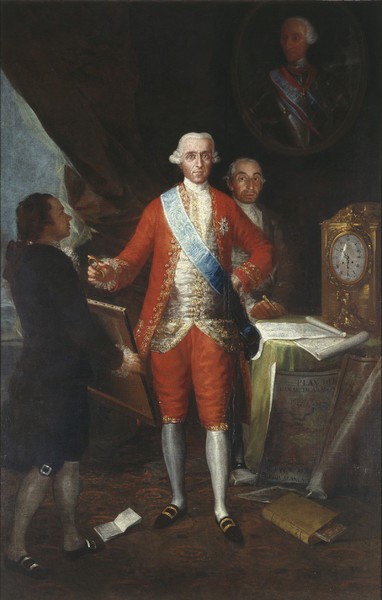- Cronología
- 1783
- Ubicación
- Bank of Spain, Madrid, Spain
- Dimensiones
- 262 x 166 cm
- Técnica y soporte
- Oil on canvas
- Reconocimiento de la autoría de Goya
- Documented work
- Titular
- Banco de España
- Ficha: realización/revisión
- 21 Jan 2010 / 15 Jun 2023
- Inventario
- P_542
PLAN DEL / CANAL DE ARAGON // AL EXCMO SEÑO[R] / FLORIDABLANCA / Año 1783 ("Plan of the Canal of Aragón", "To His Grace Señor Floridablanca, 1783", at the top and bottom of the plan).
Señor / Franco. Goya ("Señor Francisco de Goya", on the paper lying next to Goya's left foot).
This painting belonged to the Marchioness Martorell y Pontejos, and then to the Count of Miraflores and Marquis of Villanueva de Valdueza, from whom it was acquired by the Urquijo Bank. When this institution disappeared, it became the property of its present owner.
José Moñino y Redondo (Murcia, 1728-Seville, 1808) was named Chief Attorney of the Council of Castile by Charles III and sent to Rome by the king to press through the move to dissolve the Company of Jesus (1767). Upon his return to Spain, he was given the title of Count of Floridablanca and in 1776 was named First Secretary of the State, a post which he held for sixteen years under the reigns of Charles III and Charles IV. He became known above all for his interest in problems relating to agriculture and irrigation, and carried out some major hydraulic projects, including the conclusion of the Imperial Canal of Aragón.
When Goya immortalized him in this portrait, Floridablanca was at the zenith of his powers. In this official portrait, the count appears in the centre of the composition, standing, somewhat magnified in stature and with a distant air about him. In his right hand he is holding a pair of glasses and is dressed in a formal red suit, with the blue sash of Charles III across his chest.
To the left, Goya depicts himself in profile and standing out against the light. He is dressed elegantly for the occasion, with a dark coloured frock coat, white shirt with lace edging at the neck and cuffs, short trousers complete with buckles, white stockings and dark shoes, also with buckles. He is showing a painting to the count (a sketch for the church of San Francisco el Grande, according to the hypothesis of F. Nordström). Behind the count and before a table which is covered in and surrounded by various plans of the canal and a large desk clock, is an unidentified figure (perhaps the canal's engineer) holding a set of compasses in his hands. On the wall at the back, on the right-hand side, there hangs an oval-shaped bust portrait of King Charles III, whilst on the left a large curtain has been pulled back to partially reveal a landscape. On the ground and in the foreground, to either side of the count's feet, is a piece of paper bearing Goya's signature (on the left) and a volume of Práctica de la Pintura, by Acisclo A. Palomino (on the right), one of the most important Spanish treaties on the art of painting.
This is one of the first important works that Goya was commissioned to paint, and came shortly after his being elected academician of the Royal Academy of San Fernando (1780). This election granted him access to the circle of aristocrats and some of the most important figures in Madrid's society.
-
Goya 1900Ministerio de Instrucción Pública and Bellas ArtesMadrid1900consultant editors Aureliano de Beruete, Alejandro Ferrant, Marqués de Pidal and Ricardo Velázquez. May 1900cat. 93
-
Pinturas de GoyaMuseo Nacional del PradoMadrid1928consultant editor Fernando Álvarez de Sotomayor. From Apri to -May 1928cat. 4
-
Autorretratos de pintores españolesMuseo Nacional de Arte ModernoMadrid1943cat. 45
-
GoyaFestival Internacional de Granada, Palacio de Carlos VGranada1955consultant editor Enrique Lafuente Ferraricat. 87
-
Francisco de Goya. IV Centenario de la capitalidadorganized by Ayuntamiento de Madrid and Dirección General de Bellas Artes at the Casón del Buen RetiroMadrid1961consultant editor Valentín de Sambriciocat. 34
-
Goya en las colecciones madrileñasMuseo Nacional del PradoMadrid1983consultant editor Enrique Lafuente Ferrari. From April 19th to June 20th 1983cat. 3
-
Aragón, de Reino a ComunidadPalacio de la AljaferíaZaragoza2002cat. 75
-
Goya: Order and disorderMuseum of Fine ArtsBoston2014cat. 8
-
Goya: The PortraitsLondon2015cat. 3
-
Madrid2021
-
Goya, su tiempo, su vida, sus obrasMadridTipografía de Manuel G. Hernández, Impresor de la Real Casa1887p. 271, cat. CLIX
-
L'œuvre peint de Goya. 4 volsParís1928-1950vol. II, p. 24, cat. 303
-
Vie et ouvre de Francisco de GoyaParísOffice du livre1970p. 93, cat. 203
-
BarcelonaPolígrafa1970vol. I, p. 256, cat. 140
-
Goya en las colecciones madrileñasMadridAmigos del Museo del Prado1983pp.144, 145 (il.) y 146, cat. 3
-
Goya: Order & DisorderBostonMuseum of Fine Arts Boston Publications2014pp. 36-37
-
LondonNational Gallery Company2015pp. 34- 36
-
MadridBanco de España2021pp. 52-54
